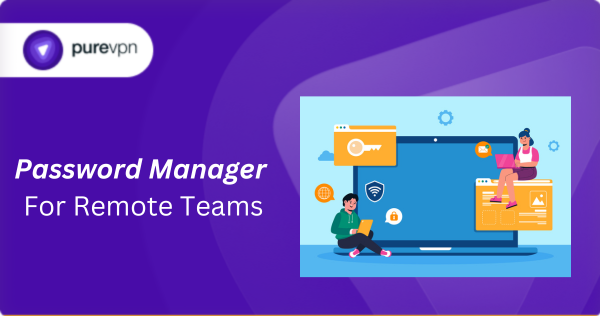Remote and hybrid work has made tools such as Slack and Notion the backbone of collaboration. However, with more apps come more passwords, and that’s usually where things often fall apart. Employees under pressure to stay productive reuse weak passwords, share logins informally, or stash them in unsecured documents or notes.
What feels like a shortcut for teamwork quickly turns into an open door for attackers. For remote teams, a single compromised Google Workspace login can be enough for an attacker to pivot through your entire digital workspace. In this guide, we’ll discuss the password problem, the risks they create, and how a password manager for remote teams can help.

Why Passwords Are a Bigger Problem in Remote Teams
Remote and hybrid teams juggle dozens of SaaS tools daily, from communication apps to cloud storage. The more accounts employees manage, the greater the temptation to cut corners with weak, reused, or shared passwords, and that’s where security gaps appear.
Password Overload and Reuse
Employees in distributed teams can’t realistically remember dozens of unique, complex logins. To cope, they recycle the same or slightly altered passwords across multiple tools. If just one of those services is breached, attackers can “stuff” the stolen password into other platforms and gain wider access.
Unsecured Sharing Practices
Many business apps charge per seat, so teams cut costs by sharing logins instead of provisioning accounts. Credentials end up pasted into Slack channels, emailed without encryption, or stored in shared documents. Once exposed, these credentials can spread far beyond the intended group.
Work–Personal Credential Overlap
Remote employees often access corporate apps on personal devices and networks. Password managers or security policies may not be enforced, leading workers to reuse personal passwords for work accounts. A breach in a non-work service (like a social app) can therefore cascade into enterprise compromise.
Lack of IT Visibility
In an office, IT teams can easily enforce controls on shared devices, monitor password practices, and audit account use. In remote setups, staff may use personal laptops or mobile devices outside corporate oversight, meaning weak or noncompliant password practices go undetected until an incident occurs.
The Consequences of Weak, Reused, or Shared Passwords
Weak, reused, or shared passwords are one of the fastest ways attackers slip into remote teams’ digital environments. Once a single login is compromised, the damage spreads quickly across the entire toolset.
Credential Stuffing and Brute-Force Attacks
Hackers rarely “guess” passwords manually anymore. Instead, they use credential stuffing tools that test stolen usernames and passwords from past breaches against services like Slack or Google Workspace.
Since remote workers often reuse personal passwords for work accounts, a breach in a social app or shopping site can hand attackers a way into corporate systems. Automated brute-force attempts are also more likely to succeed when staff rely on simple or reused credentials.
Account Takeovers and Data Leaks
Once attackers gain access to a single account, the consequences multiply. A compromised Slack account, for example, can reveal login links, API keys, and internal communications that allow attackers to pivot deeper into the organization.
In Google Workspace, access to Drive or Gmail can expose sensitive contracts, financial data, or even credentials stored in shared documents. Because many remote teams don’t have centralized monitoring, attackers can quietly exfiltrate data for weeks before being detected.
Insider Threats and Misuse
Shared credentials make accountability close to impossible. For instance, if five people log in with the same Notion or Google Workspace account, there’s no audit trail of who changed what, and when.
This lack of visibility creates cover for both malicious insiders and accidental mistakes, such as an employee deleting critical files or exposing sensitive documents, with no way to pinpoint responsibility.
Compliance and Legal Concerns
Weak password practices also put organizations out of step with compliance frameworks like GDPR, HIPAA, and SOC 2. These regulations require strict access controls, unique logins, and traceable user activity.
If regulators discover that accounts are being shared or credentials were compromised due to negligence, fines and legal repercussions can follow, often alongside reputational damage and loss of client trust.
Solve the Password Problem in Remote Teams with a Password Manager
A password manager for remote teams eliminates the need for sticky notes, Slack messages, or spreadsheets full of logins. With PureVPN’s Password Manager, you can:
- Generate strong, unique passwords for every SaaS app your team uses.
- Share credentials securely without revealing the actual password to everyone.
- Sync across all devices so employees can log in from laptops, phones, or tablets without ever storing passwords in plaintext.
Best Practices to Boost Password Security in Remote Teams
A password manager isn’t the only step. Remote teams should combine it with other security practices that strengthen defenses and close gaps attackers often exploit.
- Rotate Credentials for High-Value Accounts: Admin dashboards, billing portals, and HR systems shouldn’t use the same password indefinitely. Rotating them on a set schedule reduces the window attackers have if one leaks.
- Enforce Strong Password Policies: Set requirements for password length, complexity, and blocklists of common or breached passwords. Automated checks reduce reliance on weak or guessable logins while keeping standards consistent across all SaaS platforms.
- Adopt Phishing-Resistant MFA: Multi-factor authentication is essential, but not all MFA is equal. Move beyond SMS codes, which are vulnerable to SIM-swapping, and adopt phishing-resistant methods like FIDO2 security keys or authenticator apps.
- Use Role-Based Access: Instead of reusing one login for tools, assign individual accounts with role-based permissions. This creates accountability, clears audit trails, and reduces insider risks while keeping you aligned with compliance frameworks.
- Review and Revoke Unused Access: Schedule regular audits to catch inactive accounts or unnecessary permissions. Removing these “ghost” logins reduces the attack surface and prevents attackers from exploiting forgotten credentials.
- Provide Password Hygiene Training: Most breaches start with human error. Regularly training employees on spotting phishing attempts, avoiding reuse, and reporting suspicious activity keeps weak habits from creeping back in.
Final Word
Remote teams can’t afford to treat password security as an afterthought because that’s exactly what attackers look for when targeting SaaS environments like Slack, Notion, or Google Workspace. With a password manager for remote teams, phishing-resistant MFA, and a few smart best practices, organizations can keep collaboration seamless while locking attackers out for good.








